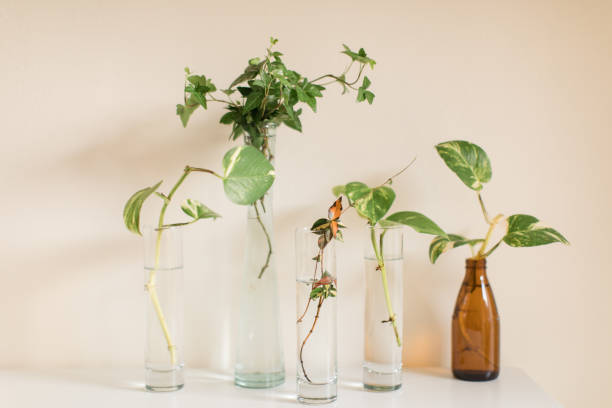You can’t go wrong with the offshoots of the ivy plant. Ivy is robust and very vigorous. It belongs to the Araliaceae family and there are six different species distributed around the world, hence ivy’s toughness and frugality.
Ivy is hardy and requires little soil nutrients. No particular location would be required and any climate and sun situation will do. Ivy grows in places where other plants die.

Make ivy cuttings
To make offshoots of the plant, cut off several smaller tendrils. Since it does not harm the plant, you can cut it in many places without a guilty conscience. Non-lignified tendrils that still have few adhesive roots, i.e. without fruits or flowers, are ideal. Since ivy varieties are poisonous, people with sensitive skin should wear gloves when working, as allergic reactions could occur.
Length of the offshoots
The ivy offshoots can be about 10-15 centimeters long. Simply remove all the leaves except for a few at the top. Then place the ivy cuttings in a glass of water and after 1-2 weeks the new roots will form. When the roots are about 3 centimeters long, simply plant the young fresh cuttings. Either somewhere in the garden or in nature or in a flower pot in the apartment or on the balcony.
Site selection for new ivy offshoots
When choosing a location, you should note that ivy should not be placed in children’s rooms because of its toxicity. In addition, please do not feed pets or livestock.
Ivy grows fast and vigorously. The more space the ivy has, the higher and further it climbs, up to 20 meters in height. This forms adhesive roots, which bother some homeowners because the ivy digs into the plaster and concrete. Tree owners don’t like ivy either, because the climbing plant forms woody trunks over the years. This allows the ivy tendrils to literally “strangle” a tree. So make sure you choose a suitable place when planting ivy.
Protection for the young plants
Ivy as a natural sunscreen works particularly well if you let it completely overgrow a scaffolding or ledge. It is also well suited as a privacy screen on fences between properties. Songbirds like the dense ivy groves as nesting sites.
Useful background knowledge on making ivy offshoots

In Germanic mythology, ivy protects against witches and black magic. Therefore, ivy is used by angels, healers, and herbalists to protect themselves from evil. Many old houses, therefore, have an almost complete ivy facade, because they also wanted to protect themselves against evil.
